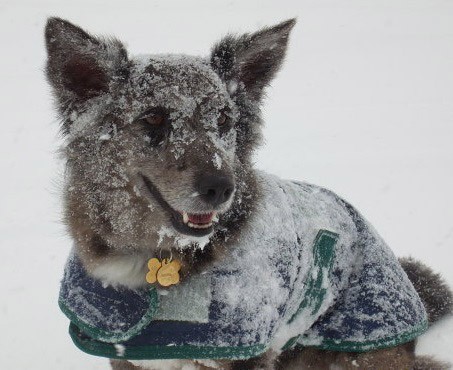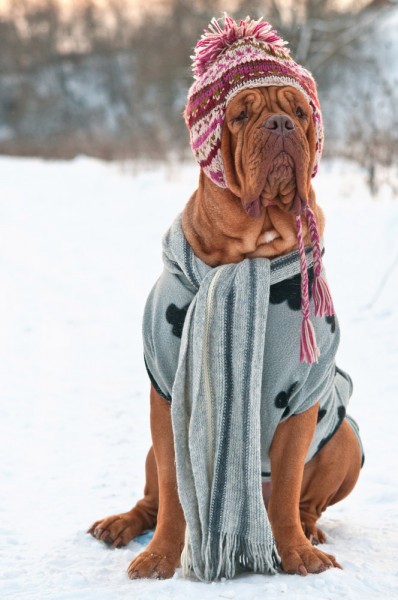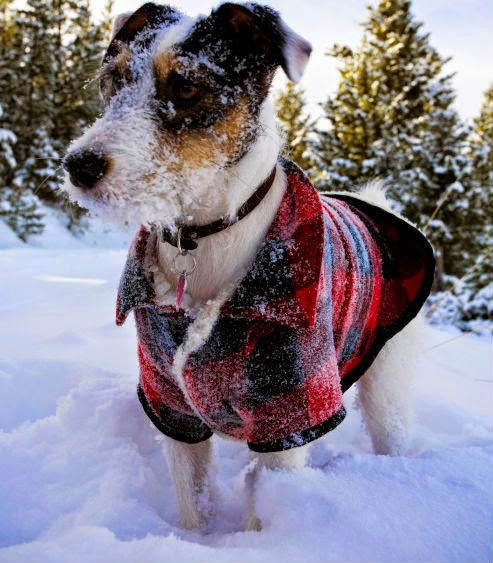Dog Safety in Cold Weather
Posted by Jenn on 01/22/2016
Compared to heat, cold might not seem like a big deal for dogs. After all, a dog’s normal body temperature is a few degrees warmer than ours, and many dogs have thick fur coats! But dogs can get frostbite and hypothermia just like we can, and it’s not safe for most dogs to spend long amounts of time outdoors in very cold climates. In addition, dogs’ tolerance to cold can vary widely according to breed, age, and health. For example, a sturdy husky won’t need a sweater or a coat, but a tiny Pomeranian might. (Sure, both dogs are fluffy, but the Pomeranian has a much lower body mass to help keep her warm.) Here are some important considerations to help keep your dog healthy and happy in the winter months.
Consider your dog’s breed, coat, size, and age.
Short-haired dogs, like pugs and boxers, and dogs with little body fat, like greyhounds, usually do not tolerate the cold very well. Dogs with substantial coats, such as retrievers, shepherds, and sheepdogs, tend to handle the cold better. Don’t forget to consider the breed’s origin and history as well. It’s no surprise that Alaskan and Siberian huskies are much happier in the cold than Basenjis or Rhodesian ridgebacks, which both hail from Africa! Note that puppies and elderly dogs typically do not do as well in the cold as their adult relatives, no matter what kind of coat they have.
If you have a small or short-haired dog in a cold climate, she may need a dog sweater or a coat to stay warm outside. Remember that wet clothing will only make your dog colder, so make sure to dry the clothing between outings or keep spares on hand.
For dogs with thick coats, appropriate grooming is important. Never shave a dog all the way down to the skin in the winter. Do brush your dog regularly, though, since matted undercoats do not dry easily and can actually make your dog colder.
Consider your dog’s overall health.
If your dog has chronic health issues, ask your veterinarian how to make him comfortable in the cold. Some conditions, such as heart or kidney disease, make it harder to regulate body temperature. Others, including arthritis, get worse in cold, damp weather.
Don’t forget that extreme cold can be harmful for even very healthy dogs. Whining, trembling, slow breathing, and lethargy are signs that your dog is too cold and needs to come inside right away. Dogs tend to hide weakness from their pack leaders, so what seems like minor discomfort could be more serious. If you suspect that your dog may have hypothermia or frostbite (which is most common on the ears and tail), consult a vet immediately.
Check the paws.
Ice balls on the feet are a common, and potentially very painful, problem for dogs. You can help prevent this from happening by trimming the hair between your dog’s toes, and by drying your dog’s feet when he comes in from snowy walks. (You may want to rinse them off, too, if you think he may have walked in areas where de-icing chemicals were used.) Rubbing a small amount of olive oil on the paws before walks can help as well. You can even buy boots for dogs, but not all dogs will tolerate them.
Keep your dog out of cold cars and away from antifreeze.
For dogs, cold cars can be just as dangerous as hot cars, for the same reason: the car traps air inside, acting like a refrigerator. Never leave your dog unattended in a car in extreme temperatures, even for short periods.
Antifreeze tastes sweet to pets, but even small amounts can be fatal. If you think your dog drank or even just licked antifreeze, get him to a vet immediately. You may also want to consider switching to an antifreeze containing propylene glycol, which is less toxic to pets, as well as pet-safe de-icing products for walkways (more info on antifreeze).
Provide adequate food and water.
The idea that dogs can get all the hydration they need from ice and snow is a myth. You should always provide plenty of clean, liquid water for your dog. Northern breeds, such as huskies and malamutes, can safely spend significant time outdoors in the winter, but even these dogs need heated water bowls to keep their water from freezing. They also need to eat more calories during the winter to maintain their body temperature and energy level.
Having said that, cold weather should not be an excuse to let your pets become obese! Most indoor dogs are less active in the winter, so they may not need larger meals just because it’s cold out. If you are not sure how much to feed your dog, consult your vet for advice.
Don’t let your dog go incognito.
As always, make sure your dog is wearing proper ID at all times. Too many dogs get lost during the winter months. For one thing, a lot of snow on the ground makes fences easier to jump. Once they are out, dogs find snow even more disorienting than we do, because it affects their ability to smell their way home.
Provide your dog with a warm place to sleep.
When you return from your snowy adventures, your dog should have a cozy place for a nap. Our elevated dog bed will keep him off the cold floor, and the optional fleece pad makes it extra inviting. It’s the perfect spot for dreaming of sugarplums… or squirrels and bacon, as the case may be!
Best wishes for a happy and healthy winter season, from all of us at
Kuranda!



